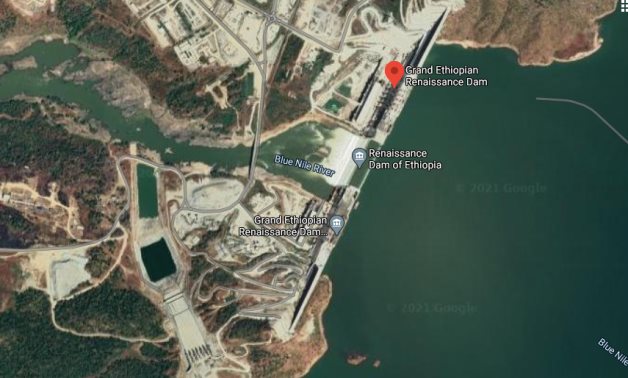
File- A Google satellite image for the controversial Grand Ethiopian Renaissance Dam (GERD)- Egypt Today
CAIRO- 26 February 2022: Egypt sent a new letter to the UN Security Council after Ethiopia announced the operation of the first two turbines to generate electricity at the controversial Grand Ethiopian Renaissance Dam (GERD)، Cairo 24 reported on Friday evening
“The Ethiopian declaration is a unilateral measure added to the unilateral filling operations of the years 2020 and 2021,” said Egypt.
The operation of the first two turbines is another fundamental breach of the 2015 Declaration of Principles Agreement, which clearly and unequivocally requires Ethiopia to reach a legally binding agreement on the rules governing the filling and operation of the dam, before starting its filling and running process, the letter said.
The letter said that Ethiopia has refrained from conducting the required studies on the hydrological, social, economic and environmental impacts of the construction of the Dam. The letter added that Ethiopia abstained from consulting in advance with other riparian countries.
Cairo stressed that these practices are a violation of the Declaration of Principles Agreement, will have direct negative effects on Egypt's rights and interests as a riparian state, and will threaten to cause great harm to it.”
Ethiopia had stated that power generation from the dam begins on Feb. 20. That is considered a pilot phase as the filling has not reached full capacity and not all turbines have been installed.
The Egyptian Ministry of Foreign Affairs issued a brief comment on the Ethiopian announcement issued on operating the Grand Ethiopian Renaissance Dam (GERD) unilaterally.
Egypt underlined that the move follows the first and second fillings of the dam, also done unilaterally, which means that Ethiopia continues to violate the 2015 Declaration of Principles signed by former Ethiopian Prime Minister Hailemariam Desalegn.
The dispute among Egypt, Sudan, and Ethiopia dates back to May 2011 when Ethiopia started building the dam; Egypt voiced concern over its water share [55.5 billion cubic meters].
Three years later, a series of tripartite talks between the two countries along with Sudan began to reach an agreement, while Ethiopia continued the dam construction.
In 2015, the three countries signed the Declaration of Principles, per which the downstream countries should not be negatively affected by the construction of the dam.
In October 2019, Egypt blamed Addis Ababa for hindering a final agreement concerning a technical problem, calling for activating Article No. 10 of the Declaration of Principles, which stipulates that if the three countries could not find a solution to these disputes, they have to ask for mediation.
Washington had brokered tripartite negotiations among the three countries, in the presence of the President of the World Bank (WB) starting from November 6, 2019 until February 27 and 28, 2020.
During these rounds of talks, tangible outcomes were agreed on among the three parties concerning the rules and mechanism of operating the dam and the filling process of the reservoir during the drought and prolonged drought; however, an agreement was not sealed.
Constructions in the Grand Renaissance Dam started on April 2, 2011 at a cost of $4.8 billion. It was built by the Italian construction and engineering company Salini Impergilo. The Italian company is headquartered in Milan. The dam is located on the Blue Nile with a capacity of 74 billion cubic meters, and is expected to generate up to 6,000 megawatts of power.
The first and second fillings were carried out in 2020 and 2021, respectively, making the total amount of water held back in the reservoir eight billion cubic meters.

Comments
Leave a Comment